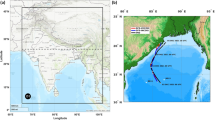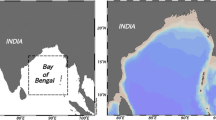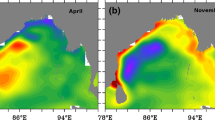Abstract
Understanding the upper-ocean response to tropical cyclones (TCs) in terms of sea surface temperature (SST) cooling is of prime importance in the prediction of TC intensity. However, the magnitude of cooling during the passage of TC varies depending on storm characteristics and pre-existing upper-ocean conditions such as the presence of ocean eddy and upper-ocean stratification. The present study investigates the upper-ocean response to two post-monsoon Bay of Bengal (BoB) cyclones, Phailin (October 2013) and Hudhud (October 2014), those followed almost a similar track, in association with pre-existing oceanic conditions using a fully coupled ocean-atmosphere modelling system. The spatial structure and temporal evolution of SST cooling induced by the two cyclones and the physical processes governing the cooling are examined. Analysis shows that the intensity of Phailin is significantly reduced when it encountered the regime of lower tropical cyclone heat potential (TCHP) associated with pre-existing cold core eddy (CCE). Intense upwelling with an average of 0.6 m/h is observed over CCE that resulted in strong temperature tendency of − 4.2 °C prior to landfall. Though average TCHP in the generation region of Hudhud was 50 kJ/cm2, the storm drew sufficient energy from the underlying ocean due to its slow translation speed. Presence of shallow thermocline over extended region and weaker upper-ocean stratification enhanced SST cooling over a larger region after passage of the TC Hudhud. Finally, the present study brings in clarity that the upper-ocean condition and the relative position of the mesoscale oceanic features to the storm track are responsible for the intensification of the TC and the recovery of the ocean surface.
















Similar content being viewed by others
References
Balaguru, K., Taraphdar, S., Leung, L. R., & Foltz, G. R. (2014). Increase in the intensity of postmonsoon Bay of Bengal tropical cyclones. Geophysical Research Letters, 41(10), 3594–3601.
Bender, M. A., & Ginis, I. (2000). Real-case simulations of hurricane – ocean interaction using a high-resolution coupled model : effects on hurricane intensity. Monthly Weather Review, 128, 917–946. https://doi.org/10.1175/1520-0493(2000)128<0917:RCSOHO>2.0.CO;2.
Bosart, L. F., Velden, C. S., Bracken, W. E., Molinari, J., & Black, P. G. (2000). Environmental influences on the rapid intensification of hurricane Opal (1995) over the Gulf of Mexico. Monthly Weather Review, 128, 322–352. https://doi.org/10.1175/1520-0493(2000)128<0322:EIOTRI>2.0.CO;2.
Chan, J., Duan, Y., & Shay, L. (2001). Tropical cyclone intensity change from a simple ocean-atmosphere coupled model. Journal of the Atmospheric Sciences, 58, 154–172. https://doi.org/10.1175/1520-0469(2001)0582.0.CO;2.
Chang, S., & Anthes, R. (1979). The mutual response of the tropical cyclone and the ocean. Journal of Physical Oceanography, 09, 128–135. https://doi.org/10.1175/1520-0485(1979)009<0128:TMROTT>2.0.CO;2.
Chaudhuri, D., Sengupta, D., D’Asaro, E., Venkatesan, R., & Ravichandran, M. (2019). Response of the salinity-stratified Bay of Bengal to cyclone Phailin. Journal of Physical Oceanography, 49, 1121–1140. https://doi.org/10.1175/JPO-D-18-0051.1 in press.
Dare, R. A., & McBride, J. L. (2011). Sea surface temperature response to tropical cyclones. Monthly Weather Review, 139, 3798–3808. https://doi.org/10.1175/MWR-D-10-05019.1.
Davis, C., et al. (2008). Prediction of landfalling hurricanes with the advanced hurricane WRF model. Monthly Weather Review, 136, 1990–2005. https://doi.org/10.1175/2007MWR2085.1.
Demaria, M., & Kaplan, J. (1994). Sea-surface temperature and the maximum intensity of atlantic tropical cyclones. Journal of Climate, 7, 1324–1334. https://doi.org/10.1175/15200442(1994)007<1324:SSTATM>2.0.CO;2.
Elsner, J. B., Strazzo, S. E., Jagger, T. H., Larow, T., & Zhao, M. (2013). Sensitivity of limiting hurricane intensity to SST in the Atlantic from observations and GCMs. Journal of Climate, 26, 5949–5957. https://doi.org/10.1175/JCLI-D-12-00433.1.
Emanuel, K. A. (1986). An air-sea interaction theory for tropical cyclones. Part I: steady-state maintenance. Journal of the Atmospheric Sciences, 43, 585–604. https://doi.org/10.1175/15200469(1986)043<0585:AASITF>2.0.CO2.
Gray, W. M. (1998). The formation of tropical cyclones. Meteorology and Atmospheric Physics, 67, 37–69.
Jaimes, B., Shay, L. K., & Halliwell, G. R. (2011). The response of quasigeostrophic oceanic vortices to tropical cyclone forcing. Journal of Physical Oceanography, 41, 1965–1985. https://doi.org/10.1175/JPO-D-11-06.1.
Kara, A. B., Rochford, P. A., & Hurlburt, H. E. (2000). An optimal definition for ocean mixed layer depth. Journal of Geophysical Research, 105, 16,803–16,821.
Knaff, J. A., DeMaria, M., Sampson, C. R., Peak, J. E., Cummings, J., & Schubert, W. H. (2013). Upper oceanic energy response to tropical cyclone passage. Journal of Climate, 26, 2631–2650. https://doi.org/10.1175/JCLI-D-12-00038.1.
Lin, Y.-L., Chen, S.-Y., & Hill, C. M. (2005). Control parameters for the influence of a mesoscale mountain range on cyclone track continuity and deflection. Journal of the Atmospheric Sciences, 62, 1849–1866.
Lu, Z., Wang, G., & Shang, X. (2016). Response of a preexisting cyclonic ocean eddy to a typhoon. Journal of Physical Oceanography, 46, 2403–2410. https://doi.org/10.1175/JPO-D-16-0040.1.
Mandal, M., Singh, K. S., Balaji, M., & Mohapatra, M. (2016). Performance of WRF-ARW model in real-time prediction of Bay of Bengal cyclone ’Phailin’. Pure and Applied Geophysics, 173, 1783–1801. https://doi.org/10.1007/s00024-015-1206-7.
McPhaden, M. J., Foltz, G. R., Lee, T., Murty, V. S. N., Ravichandran, M., Vecchi, G. A., Vialard, J., Wiggert, J. D., & Yu, L. (2009). Ocean-atmosphere interactions during cyclone Nargis. EOS (Washington. DC)., 90, 53–54. https://doi.org/10.1029/2009EO070001.
Neetu, S., Lengaigne, M., Vincent, E. M., Vialard, J., Madec, G., Samson, G., Kumar, M. R. R., & Durand, F. (2012). Influence of upper-ocean stratification on tropical cyclone-induced surface cooling in the Bay of Bengal. Journal of Geophysical Research, Oceans, 117, 1–19. https://doi.org/10.1029/2012JC008433.
Palmen, E. (1948). On the formation and structure of tropical hurricanes. Geophysica, 3, 26–38 551.515.2, 551.587.
Patnaik, K. V. K. R. K., Maneesha, K., Sadhuram, Y., Prasad, K. V. S. R., Ramana Murty, T. V., & Brahmananda Rao, V. (2014). East India coastal current induced eddies and their interaction with tropical storms over Bay of Bengal. Journal of Operational Oceanography, 7, 58–68. https://doi.org/10.1080/1755876X.2014.11020153.
Petrova, L. I. (2010). Estimating the maximum potential intensity of tropical cyclones. Russian Meteorology and Hydrology, 35, 371–377. https://doi.org/10.3103/S1068373910060026.
Pond, S., & Pickard, G. L. (1983). Introductory dynamical oceanography (p. 349). Oxford: Elsevier Butterworth-Heinemann.
Qiu, Y., Han, W., Lin, X., West, B., Li, Y., Xing, W., Zhang, X., Arulananthan, K., & Guo, X. (2019). Upper ocean response to the super tropical cyclone Phailin (2013) over the freshwater region of the Bay of Bengal. Journal of Physical Oceanography, 49, 1201–1228. https://doi.org/10.1175/JPO-D-18-0228.1.
Riehl, H. (1950). A model of hurricane formation. Journal of Applied Physics, 21, 917–925. https://doi.org/10.1063/1.1699784.
Sadhuram, Y., Rao, B. P., Rao, D. P., Shastri, P. N. M., & Subrahmanyam, M. V. (2004). Seasonal variability of cyclone heat potential in the Bay of Bengal. Natural Hazards, 32, 191–209. https://doi.org/10.1023/B:NHAZ.0000031313.43492.a8.
Scharroo, R., Smith, W. H. F., & Lillibridge, J. L. (2005). Satellite altimetry and the intensification of Hurricane Katrina. EOS. Transactions of the American Geophysical Union, 86, 366. https://doi.org/10.1029/2005EO400004.
Shay, L. K., & Uhlhorn, E. W. (2008). Loop current response to hurricanes Isidore and Lili. Monthly Weather Review, 136, 3248–3274. https://doi.org/10.1175/2007MWR2169.1.
Shay, L. K., Goni, G. J., & Black, P. G. (2000). Effects of a warm oceanic feature on hurricane opal. Monthly Weather Review, 128, 1366–1383. https://doi.org/10.1175/1520-0493(2000)128<1366:EOAWOF>2.0.CO;2.
Sun, D., Ritesh, G., Guido, C., Zafer, B., & Menas, K. (2006). Satellite altimetry and the intensification of hurricane Katrina. EOS. Transactions of the American Geophysical Union, 87(8).
Sun, L., Li, Y. X., Yang, Y. J., Wu, Q., Chen, X. T., Li, Q. Y., Bin Li, Y., & Xian, T. (2014). Effects of super typhoons on cyclonic ocean eddies in the western North Pacific: a satellite data-based evaluation between 2000 and 2008. Journal of Geophysical Research, Oceans, 119, 5585–5598. https://doi.org/10.1002/2013JC009575.
Tuleya, R. E., & Kurihara, Y. (1982). A note on the sea surface temperature sensitivity of a numerical model of tropical storm genesis. Monthly Weather Review, 110, 2063–2069. https://doi.org/10.1175/1520-0493(1982)110<2063:ANOTSS>2.0.CO;2.
Vissa, N. K., Satyanarayana, A. N. V., & Kumar, B. P. (2013). Response of upper ocean and impact of barrier layer on Sidr cyclone induced sea surface cooling. Ocean Science Journal, 48(3), 279–288.
Wada, A. (2015). Verification of tropical cyclone heat potential for tropical cyclone intensity forecasting in the Western North Pacific. Journal of Oceanography, 71(4), 373–387. https://doi.org/10.1007/s10872-015-0298-0.
Walker, N. D., Leben, R. R., & Balasubramanian, S. (2005). Hurricane-forced upwelling and chlorophyll a enhancement within cold-core cyclones in the Gulf of Mexico. Geophysical Research Letters, 32, 1–5. https://doi.org/10.1029/2005GL023716.
Wang, J. W., & Han, W. (2014). The Bay of Bengal upper-ocean response to tropical cyclone forcing during 1999. Journal of Geophysical Research, Oceans, 119, 98–120. https://doi.org/10.1002/2013JC008965.
Yablonsky, R., & Ginis, I. (2009). Limitation of one-dimensional ocean models for coupled hurricane–ocean model forecasts. Monthly Weather Review, 137, 4410–4419. https://doi.org/10.1175/2009MWR2863.1.
Zheng, Z. W., Ho, C. R., & Kuo, N. J. (2008). Importance of pre-existing oceanic conditions to upper ocean response induced by super typhoon Hai-Tang. Geophysical Research Letters, 35, 1–5. https://doi.org/10.1029/2008GL035524.
Zheng, Z. W., Ho, C. R., Zheng, Q., Lo, Y. T., Kuo, N. J., & Gopalakrishnan, G. (2010). Effects of preexisting cyclonic eddies on upper ocean responses to Category 5 typhoons in the western North Pacific. Journal of Geophysical Research, Oceans, 115, 1–11. https://doi.org/10.1029/2009JC005562.
Acknowledgments
Daily optimum interpolation SST (OISST) and chlorophyll a (Chl-a) concentration are obtained from APDRC (http://apdrc.soest.hawaii.edu/index.php). The sea surface height and the geostrophic currents are provided by AVISO (http://www.aviso.altimetry.fr/en/data/products/sea-surface-height-products/global.html). Argo temperature data is obtained from CORIOLIS (http://www.coriolis.eu.org/). The initial and boundary condition for both ARW-WRF and ROMS model were derived from the latest version of Climate Forecast System (CFSv2) operational analyses developed in the NCEP.
Author information
Authors and Affiliations
Corresponding author
Additional information
Publisher’s note
Springer Nature remains neutral with regard to jurisdictional claims in published maps and institutional affiliations.
This article is part of the Topical Collection on Terrestrial and Ocean Dynamics: India Perspective
Electronic supplementary material
ESM 1
(DOCX 424 kb)
Rights and permissions
About this article
Cite this article
Dutta, D., Mani, B. & Dash, M.K. Dynamic and thermodynamic upper-ocean response to the passage of Bay of Bengal cyclones ‘Phailin’ and ‘Hudhud’: a study using a coupled modelling system. Environ Monit Assess 191 (Suppl 3), 808 (2019). https://doi.org/10.1007/s10661-019-7704-9
Received:
Accepted:
Published:
DOI: https://doi.org/10.1007/s10661-019-7704-9




